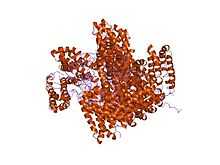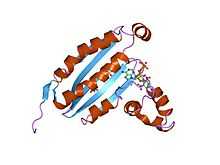Two-component regulatory system
| Histidine kinase | |||||||||
|---|---|---|---|---|---|---|---|---|---|
| Identifiers | |||||||||
| Symbol | His_kinase | ||||||||
| Pfam | PF06580 | ||||||||
| InterPro | IPR010559 | ||||||||
| |||||||||
| His Kinase A (phospho-acceptor) domain | |||||||||
|---|---|---|---|---|---|---|---|---|---|
 solution structure of the homodimeric domain of envz from escherichia coli by multi-dimensional nmr. | |||||||||
| Identifiers | |||||||||
| Symbol | HisKA | ||||||||
| Pfam | PF00512 | ||||||||
| Pfam clan | CL0025 | ||||||||
| InterPro | IPR003661 | ||||||||
| SMART | HisKA | ||||||||
| SCOP | 1b3q | ||||||||
| SUPERFAMILY | 1b3q | ||||||||
| |||||||||
| Histidine kinase | |||||||||
|---|---|---|---|---|---|---|---|---|---|
| Identifiers | |||||||||
| Symbol | HisKA_2 | ||||||||
| Pfam | PF07568 | ||||||||
| Pfam clan | CL0025 | ||||||||
| InterPro | IPR011495 | ||||||||
| |||||||||
| Histidine kinase | |||||||||
|---|---|---|---|---|---|---|---|---|---|
| Identifiers | |||||||||
| Symbol | HisKA_3 | ||||||||
| Pfam | PF07730 | ||||||||
| Pfam clan | CL0025 | ||||||||
| InterPro | IPR011712 | ||||||||
| |||||||||
| Signal transducing histidine kinase, homodimeric domain | |||||||||
|---|---|---|---|---|---|---|---|---|---|
 structure of chea domain p4 in complex with tnp-atp | |||||||||
| Identifiers | |||||||||
| Symbol | H-kinase_dim | ||||||||
| Pfam | PF02895 | ||||||||
| InterPro | IPR004105 | ||||||||
| SCOP | 1b3q | ||||||||
| SUPERFAMILY | 1b3q | ||||||||
| |||||||||
| Histidine kinase N terminal | |||||||||
|---|---|---|---|---|---|---|---|---|---|
| Identifiers | |||||||||
| Symbol | HisK_N | ||||||||
| Pfam | PF09385 | ||||||||
| InterPro | IPR018984 | ||||||||
| |||||||||
| Osmosensitive K+ channel His kinase sensor domain | |||||||||
|---|---|---|---|---|---|---|---|---|---|
| Identifiers | |||||||||
| Symbol | KdpD | ||||||||
| Pfam | PF02702 | ||||||||
| InterPro | IPR003852 | ||||||||
| |||||||||
In the field of molecular biology, a two-component regulatory system serves as a basic stimulus-response coupling mechanism to allow organisms to sense and respond to changes in many different environmental conditions.[1] They typically consist of a membrane-bound histidine kinase that senses a specific environmental stimulus and a corresponding response regulator that mediates the cellular response, mostly through differential expression of target genes.[2] Two component signaling systems are widely occurring in prokaryotes whereas only a few two-component systems have been identified in eukaryotic organisms.[1]
Mechanism of action
Signal transduction occurs through the transfer of phosphoryl groups from adenosine triphosphate (ATP) to a specific histidine residue in the histidine kinases (HK). This is an autophosphorylation reaction. The response regulators (RRs) were shown to be phosphorylated on an aspartate residue and to be protein phosphatases for the histidine kinases.[3] The response regulators are therefore enzymes with a covalent intermediate that alters response-regulator output function.[4] Phosphorylation causes the response regulator's conformation to change, usually activating an attached output domain, which then leads to the stimulation (or repression) of expression of target genes. The level of phosphorylation of the response regulator controls its activity.[5][6] Some HK are bifunctional, catalysing both the phosphorylation and dephosphorylation of their cognate RR. The input stimuli can regulate either the kinase or phosphatase activity of the bifunctional HK.
Function
Two-component signal transduction systems enable bacteria to sense, respond, and adapt to a wide range of environments, stressors, and growth conditions.[7] Some bacteria can contain up to as many as 200 two-component systems that need tight regulation to prevent unwanted cross-talk.[8] These pathways have been adapted to respond to a wide variety of stimuli, including nutrients, cellular redox state, changes in osmolarity, quorum signals, antibiotics, temperature, chemoattractants, pH and more.[9][10] In Escherichia coli, the EnvZ/OmpR osmoregulation system controls the differential expression of the outer membrane porin proteins OmpF and OmpC.[11] The KdpD sensor kinase proteins regulate the kdpFABC operon responsible for potassium transport in bacteria including E. coli and Clostridium acetobutylicum.[12] The N-terminal domain of this protein forms part of the cytoplasmic region of the protein, which may be the sensor domain responsible for sensing turgor pressure.[13]
Phospho-relay system
A variant of the two-component system is the phospho-relay system. Here a hybrid HK autophosphorylates and then transfers the phosphoryl group to an internal receiver domain, rather than to a separate RR protein. The phosphoryl group is then shuttled to histidine phosphotransferase (HPT) and subsequently to a terminal RR, which can evoke the desired response.[14][15]
Histidine kinases
Signal transducing histidine kinases are the key elements in two-component signal transduction systems.[16][17] Examples of histidine kinases are EnvZ, which plays a central role in osmoregulation,[18] and CheA, which plays a central role in the chemotaxis system.[19] Histidine kinases usually have an N-terminal ligand-binding domain and a C-terminal kinase domain, but other domains may also be present. The kinase domain is responsible for the autophosphorylation of the histidine with ATP, the phosphotransfer from the kinase to an aspartate of the response regulator, and (with bifunctional enzymes) the phosphotransfer from aspartyl phosphate back to ADP or to water.[20] The kinase core has a unique fold, distinct from that of the Ser/Thr/Tyr kinase superfamily.
HKs can be roughly divided into two classes: orthodox and hybrid kinases.[21][22] Most orthodox HKs, typified by the E. coli EnvZ protein, function as periplasmic membrane receptors and have a signal peptide and transmembrane segment(s) that separate the protein into a periplasmic N-terminal sensing domain and a highly conserved cytoplasmic C-terminal kinase core. Members of this family, however, have an integral membrane sensor domain. Not all orthodox kinases are membrane bound, e.g., the nitrogen regulatory kinase NtrB (GlnL) is a soluble cytoplasmic HK.[6] Hybrid kinases contain multiple phosphodonor and phosphoacceptor sites and use multi-step phospho-relay schemes instead of promoting a single phosphoryl transfer. In addition to the sensor domain and kinase core, they contain a CheY-like receiver domain and a His-containing phosphotransfer (HPt) domain.
See also
- P2CS database
References
- ↑ 1.0 1.1 Stock AM, Robinson VL, Goudreau PN (2000). "Two-component signal transduction". Annu. Rev. Biochem. 69 (1): 183–215. doi:10.1146/annurev.biochem.69.1.183. PMID 10966457.
- ↑ Mascher T, Helmann JD, Unden G (2006). "Stimulus perception in bacterial signal-transducing histidine kinases". Microbiol. Mol. Biol. Rev. 70 (4): 910–38. doi:10.1128/MMBR.00020-06. PMC 1698512. PMID 17158704.
- ↑ http://www.jbc.org/content/264/36/21770.full.pdf
- ↑ http://www.ncbi.nlm.nih.gov/pmc/articles/PMC206329/
- ↑ Stock JB, Ninfa AJ, Stock AM (1989). "Protein phosphorylation and regulation of adaptive responses in bacteria". Microbiol. Rev. 53 (4): 450–90. PMC 372749. PMID 2556636.
- ↑ 6.0 6.1 Stock AM, Robinson VL, Goudreau PN (2000). "Two-component signal transduction". Annu. Rev. Biochem. 69: 183–215. doi:10.1146/annurev.biochem.69.1.183. PMID 10966457.
- ↑ Skerker JM, Prasol MS, Perchuk BS, Biondi EG, Laub MT (October 2005). "Two-component signal transduction pathways regulating growth and cell cycle progression in a bacterium: a system-level analysis". PLoS Biol. 3 (10): e334. doi:10.1371/journal.pbio.0030334. PMC 1233412. PMID 16176121.
- ↑ Laub MT, Goulian M (2007). "Specificity in two-component signal transduction pathways". Annu. Rev. Genet. 41: 121–45. doi:10.1146/annurev.genet.41.042007.170548. PMID 18076326.
- ↑ Wolanin PM, Thomason PA, Stock JB (September 2002). "Histidine protein kinases: key signal transducers outside the animal kingdom". Genome Biol. 3 (10): REVIEWS3013. doi:10.1186/gb-2002-3-10-reviews3013. PMC 244915. PMID 12372152.
- ↑ Attwood PV, Piggott MJ, Zu XL, Besant PG (2007). "Focus on phosphohistidine". Amino Acids 32 (1): 145–56. doi:10.1007/s00726-006-0443-6. PMID 17103118.
- ↑ Buckler DR, Anand GS, Stock AM (2000). "Response-regulator phosphorylation and activation: a two-way street?". Trends Microbiol. 8 (4): 153–6. doi:10.1016/S0966-842X(00)01707-8. PMID 10754569.
- ↑ Treuner-Lange A, Kuhn A, Durre P (July 1997). "The kdp system of Clostridium acetobutylicum: cloning, sequencing, and transcriptional regulation in response to potassium concentration". J. Bacteriol. 179 (14): 4501–12. PMC 179285. PMID 9226259.
- ↑ Walderhaug MO, Polarek JW, Voelkner P, Daniel JM, Hesse JE, Altendorf K, Epstein W (April 1992). "KdpD and KdpE, proteins that control expression of the kdpABC operon, are members of the two-component sensor-effector class of regulators". J. Bacteriol. 174 (7): 2152–9. PMC 205833. PMID 1532388.
- ↑ Varughese KI (April 2002). "Molecular recognition of bacterial phosphorelay proteins". Curr. Opin. Microbiol. 5 (2): 142–8. doi:10.1016/S1369-5274(02)00305-3. PMID 11934609.
- ↑ Hoch JA, Varughese KI (September 2001). "Keeping signals straight in phosphorelay signal transduction". J. Bacteriol. 183 (17): 4941–9. doi:10.1128/jb.183.17.4941-4949.2001. PMC 95367. PMID 11489844.
- ↑ Perego M, Hoch JA (March 1996). "Protein aspartate phosphatases control the output of two-component signal transduction systems". Trends Genet. 12 (3): 97–101. doi:10.1016/0168-9525(96)81420-X. PMID 8868347.
- ↑ West AH, Stock AM (June 2001). "Histidine kinases and response regulator proteins in two-component signaling systems". Trends Biochem. Sci. 26 (6): 369–76. doi:10.1016/S0968-0004(01)01852-7. PMID 11406410.
- ↑ Tomomori C, Tanaka T, Dutta R, Park H, Saha SK, Zhu Y, Ishima R, Liu D, Tong KI, Kurokawa H, Qian H, Inouye M, Ikura M (August 1999). "Solution structure of the homodimeric core domain of Escherichia coli histidine kinase EnvZ". Nat. Struct. Biol. 6 (8): 729–34. doi:10.1038/11495. PMID 10426948.
- ↑ Bilwes AM, Alex LA, Crane BR, Simon MI (January 1999). "Structure of CheA, a signal-transducing histidine kinase". Cell 96 (1): 131–41. doi:10.1016/S0092-8674(00)80966-6. PMID 9989504.
- ↑ Vierstra RD, Davis SJ (December 2000). "Bacteriophytochromes: new tools for understanding phytochrome signal transduction". Semin. Cell Dev. Biol. 11 (6): 511–21. doi:10.1006/scdb.2000.0206. PMID 11145881.
- ↑ Alex LA, Simon MI (April 1994). "Protein histidine kinases and signal transduction in prokaryotes and eukaryotes". Trends Genet. 10 (4): 133–8. doi:10.1016/0168-9525(94)90215-1. PMID 8029829.
- ↑ Parkinson JS, Kofoid EC (1992). "Communication modules in bacterial signaling proteins". Annu. Rev. Genet. 26: 71–112. doi:10.1146/annurev.ge.26.120192.000443. PMID 1482126.
This article incorporates text from the public domain Pfam and InterPro IPR011712
This article incorporates text from the public domain Pfam and InterPro IPR010559
This article incorporates text from the public domain Pfam and InterPro IPR003661
This article incorporates text from the public domain Pfam and InterPro IPR011495
This article incorporates text from the public domain Pfam and InterPro IPR004105
This article incorporates text from the public domain Pfam and InterPro IPR011126
This article incorporates text from the public domain Pfam and InterPro IPR003852